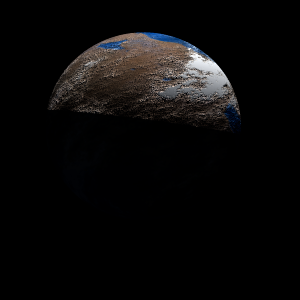|
|
Space Astro
|
Info for exoplanet "Nosezo-hakya"
| Scientific (actual) data |
|---|
| Name | HD 10180 d |
| Planet status | Confirmed |
| Mass sini | 0.0369694 |
| Orbital period | 16.3579 |
| Semi major axis | 0.1286 |
| Orbit eccentricity | 0.088 |
| Angular distance | 0.003264 |
| Discovered | 2010 |
| Updated | 2012-01-30 |
| Omega | 315 |
| Publication | Published in a refereed paper |
| Detection type | Radial Velocity |
| Star name | HD 10180 |
| Right ascension | 24.48° |
| Declination | -60.51° |
| Mag v | 7.33 |
| Star distance | 39.4 |
| Star metallicity | 0.08 |
| Star mass | 1.06 |
| Star sp type | G1V |
| Star age | 4.3 |
| Star temperature | 5911 |
| Wikipedia article | HD 10180 d |
Back
| |
| Fictional info (?) |
|---|
| Suggested name | Nosezo-hakya |
| Planet type | Terrestrial |
| It has the longest rotation period (445 days) of any planet in its solar system and rotates in the opposite direction to most other planets.
As seen from HD 10180, in a frame of reference that rotates with the orbital motion, it appears to rotate only once every two years. |
| Estimated population | 25000000000 |
| Atmosphere | Carbon dioxide | 86% |
| Water | 6.6% |
| Methane | 6.5% |
| Oxygen | 0.00026% |
| Atmospheric pressure | 0.008 bar |
 |
| Moon | Beso-zu | Large potato shaped crater-filled moon |
| Jinyo-pya | Medium-sized almost round rocky moon |
| Myaguhe Ho | Huge potato shaped gaseous asteroid |
| Chiora Hyoga | Small round crater-filled comet |
| Google search for Nosezo-hakya |
|
Website by Joachim Michaelis
|
|
|
|